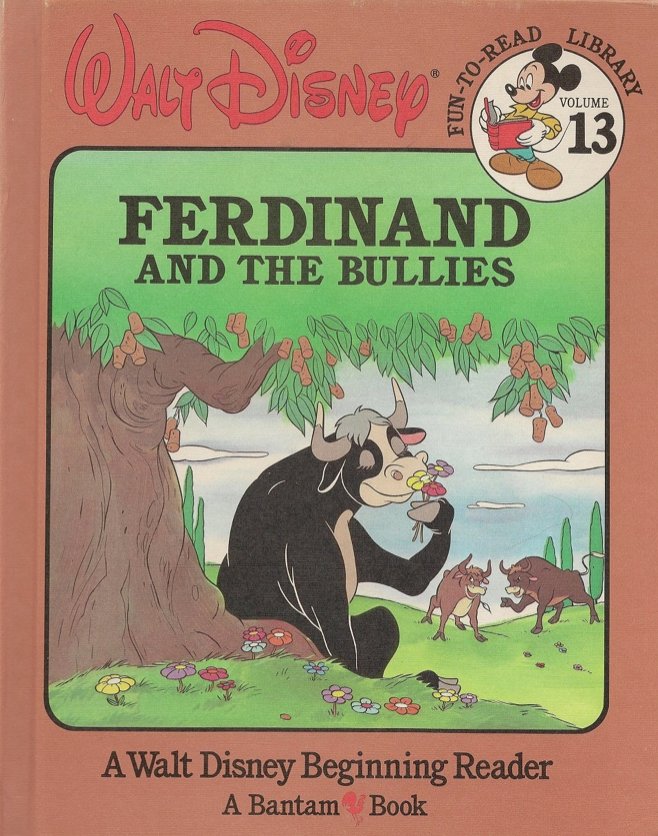Ferdinand and the Bullies
Book Module Navigation
Summary
Ferdinand and the Bullies is a story about what it means to be tough and the value of individuality.
Ferdinand is a bull that doesn’t want to get picked to go to the bull ring, like all the other bulls do. Ferdinand is happy just sitting underneath his favorite cork tree and smelling the flowers. The other bulls start to pick on Ferdinand because he doesn’t want to fight like the rest of them. Ferdinand ignores their pestering until they start picking on Ferdinand’s nephew Ramon. Ferdinand takes a stand against the other bulls, and they stop picking on both Ferdinand and Ramon after seeing Ferdinand’s strength.
Guidelines for Philosophical Discussion
Ferdinand and the Bullies deals with the concept of individualism and the social consequences that come along with it. There is also a strong theme of “what does it really mean to be tough?” Ferdinand is a bull who prefers to sit underneath his favorite cork tree and smell the flowers. All the other bulls practice fighting so they can get picked to go to the city and fight in the bull ring. Ferdinand is picked on for not fighting and not wanting to go to the bull ring. The only bull that doesn’t pick on Ferdinand is his young nephew Ramon. Ferdinand is a mentor figure to Ramon, who looks up to him. Throughout the story, the other bulls play tricks on Ferdinand, but he refuses to be provoked. Ramon is curious about this and wants Ferdinand to stand up to the other bulls, but Ferdinand refuses. Instead, he goes about life his own way and continues to do what he likes. However, when the other bulls start to bully Ramon, Ferdinand jumps in and beats them all up. Ramon and all the other bulls realize that he is actually very tough, and all the other bulls stay away. From then on, the other bulls leave Ramon and Ferdinand alone. They sit and smell flowers under the cork tree together at the end.
Ferdinand’s choice to be different inspires Ramon to want to be just like him. Ramon might represent the reader in his fascination with Ferdinand’s individualism, and it is easy to be sympathetic towards both Ferdinand and Ramon because of this situation. Ferdinand is the source of morals, and Ramon is like the reader as he reacts to them, learns, and changes. At first, Ramon wondered why any bull would not want to go to the bull ring. But after Ferdinand teaches Ramon some important lessons, Ramon realizes that on can be happy even though one is different. This raises the question, why is it looked down upon to show freedom of expression? Just because most people are doing the same thing doesn’t mean that everyone wants to do the same thing. Also, when someone is different, what gives others the right to challenge that person’s individuality?
Bullying is also an important theme in this book. The other bulls go through the motions of bullying Ferdinand in hopes of making him angry, attempting to provoke him to act just like the other bulls who like to fight. These bulls try everything, from tying Ferdinand up to putting ants in the oats. Ferdinand knows they are trying to provoke him and ignores him the best he can. By not giving them what they want, he frustrates them. Eventually, the bullies give up and start pestering Ramon. When Ferdinand hears of this, he gets angry and fights the other bulls off—showing his bullfighting abilities. This raises the question of why judge someone when you don’t know much about them. Just because someone is different on the outside doesn’t mean they are not a good person.
The final and probably most important moral theme of the book is the question of what it really means to be tough. Are the bullies who are always fighting tough? Or is Ferdinand, who lives his life the way he wants and can’t be changed by the others, the tough one? Ferdinand shows that being tough is far more complex than just fighting all the time.
Questions for Philosophical Discussion
Individuality
“It takes a strong bull to go his own way and forget the things those bullies say.”
- Does Ferdinand like to fight?
- What did Ferdinand like to do instead of fight?
- Is Ferdinand happy that he is different?
- How is Ramon different than the other bulls? How does he treat Ferdinand?
- Why do the Bulls want to get to the bullring?
- Why are all the other bulls younger then Ferdinand?
Bullying
“The young bulls watched Ferdinand as he sat under his cork tree. They made fun of him all day long.”
- What does Ferdinand tell Ramon when Ramon asks why Ferdinand lets the bulls tease him?
- Why do the bulls tease Ferdinand?
- What do the other bulls do to Ferdinand? What does he do in response?
- What causes Ferdinand to finally get mad?
Being Tough
“A wise bulls gets angry only when he must. He only uses his strength to help someone who is really in need.”
- What do the other bulls do after Ferdinand fights them?
- How does Ramon’s opinion of Ferdinand change after Ferdinand stands up for him?
- What do Ferdinand and Ramon do at the end of the story?
- How do the other bulls treat Ferdinand and Ramon at the end of the story?
- Does fighting someone make you “tough”?
- What makes the other bulls finally realize that Ferdinand is tough?
- Is this the only way to be tough?
- Was Ferdinand tough the whole time?
Original questions and guidelines for philosophical discussion by Tiana Shea and Tyrel Musil. Edited June 2020 by The Janet Prindle Institute for Ethics.
Find tips for leading a philosophical discussion on our Resources page.






